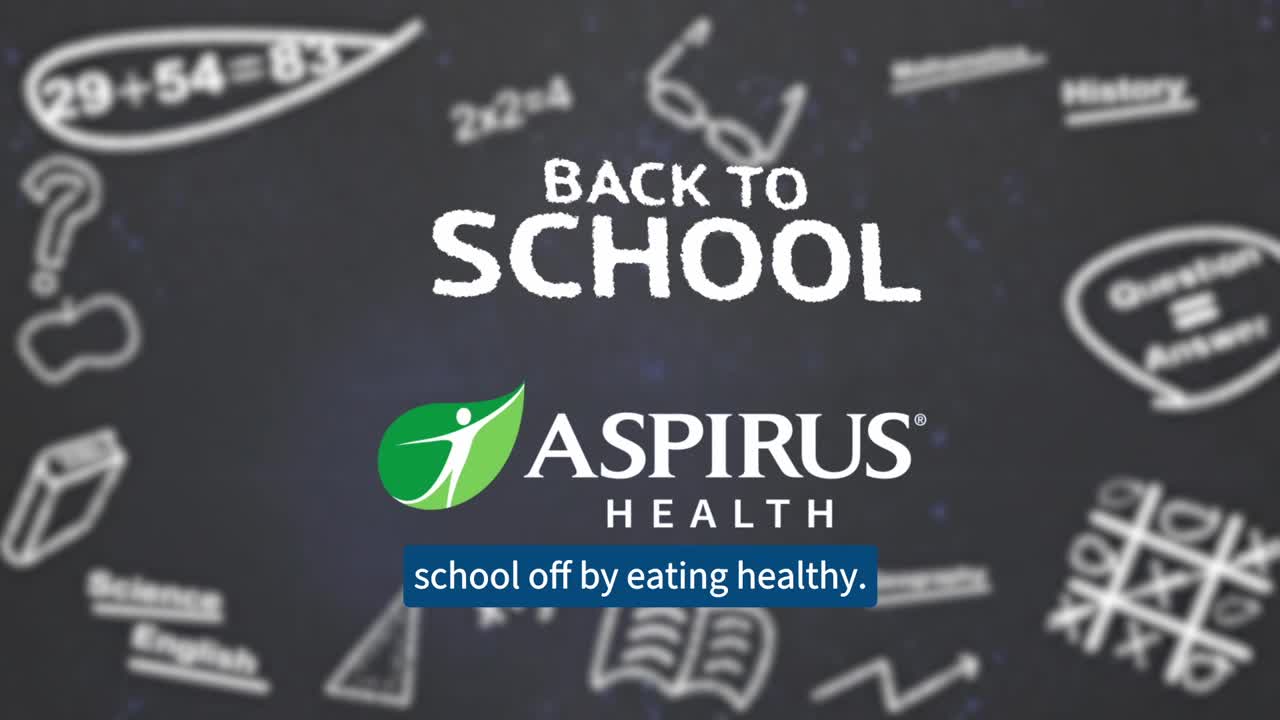Fueling Success: A Registered Dietitian's Back-to-School Nutrition Advice for Parents
8/3/2023

Ashley Chrisinger, Aspirus Registered Dietitian
As the back-to-school
season approaches, parents are gearing up to ensure their children are
well-prepared academically and emotionally. However, one aspect that is often
overlooked is the critical role of nutrition in a child's growth and
development.
Kids rapidly grow and
their bodies lay the foundation for a healthy future, so it is essential to
prioritize healthy eating habits. Aspirus
Registered Dietitian Ashley Chrisinger emphasizes that this window of
childhood is crucial for building strong bodies that can last until their
eighties or nineties.
“This is the time for
bone growth, as well as muscle and brain development, so they need a certain
amount of specific nutrients every day,” says Chrisinger. “These nutrients
include protein, essential fatty acids, calcium, iron, beta-carotene, and
various phytonutrients and minerals, which are predominantly found in fruits
and vegetables.”
Surprisingly, though,
school age kids have the lowest diet quality compared to other age groups,
despite having the highest nutritional needs, according to the National
Institutes of Health (NIH). To help parents make informed decisions, Chrisinger
shared her expert advice on how to nourish kids for a successful school year:
Start with a Balanced
Breakfast
A healthy breakfast is
a crucial start to the day, providing sustained energy and reducing the urge
for unhealthy snacks later in the day. Chrisinger encourages protein-rich
breakfasts with fruits or vegetables to keep kids full and focused throughout
the morning. She says, “choosing the right balanced breakfast in the morning
impacts how that child is going to be able to behave, pay attention and
socialize at school. So instead of getting into the habit of just grabbing
‘convenience items,’ or carbohydrates such as a bagel or some cereal, try to
balance it out by adding some protein, fruit and vegetables.”
Mornings can be
hectic, so Chrisinger says planning ahead and prepping nutritious options can
help simplify breakfast routines. Quick and easy options like eggs with
vegetables or fruit with yogurt can be excellent choices to ensure a
well-rounded meal.
Snack Smartly
Snacks between meals
are essential for children, as their lower energy stores require frequent
replenishment to sustain their active lifestyles and attentive minds.
“During a school day,
usually there are built in snack times between meals, especially for the little
kids that are growing faster and have even lower nutrient stores. It’s not just
about getting more calories in, though. Nutrient dense snacks that include
protein and fiber will make energy last and neurons fire efficiently, which
helps kids stay on task in school,” explains Chrisinger.
Pack a Nutrient-Rich Lunch
To ensure a
well-balanced diet, parents can use the MyPlate model, which visually
represents the ideal proportions of food groups in a meal. Half of the plate
should consist of fruits and vegetables, a quarter of whole grains and the
remaining quarter of lean protein. Packing a school lunch based on this model
ensures that children receive all necessary nutrients.
Chrisinger wants
parents to keep in mind that portion sizes for kids change as they grow and
develop. “Little kindergartners entering the school system require smaller
portions of fruits, vegetables, protein and grains. As they get older, their
portion sizes get a little bigger and a little bigger due to their higher
energy demands, but the balance stays the same.”
The MyPlate website provides age-specific
guidance on calorie needs and portion sizes of each food group for school
lunches.
Teach Kids to Choose
Nutrition
When it comes to
school lunches, parents and school systems play the role of providing healthy
food options, while children decide how much and which items they will eat.
“We can pack a school
lunch that has all the necessary nutrients and food groups, and the school
lunch system can offer fruits and vegetables every single day. But on top of
that, kids need nutrition education to be able to select for themselves what
they're going to choose and how much they're going to choose,” says Chrisinger.
Nutrition education is
essential to empower kids to make healthier choices when selecting from the
lunch line or their packed lunches. Encourage children to choose fruits and
vegetables by creating a positive environment and promoting healthy eating habits
among their peers.
Lead by Example
Parents play a pivotal
part in being role models for healthy eating habits. Research shows that
children are more likely to eat better-quality diets and consume more fruits
and vegetables if they see their parents doing the same. Keep fresh fruits and
vegetables accessible and visible at home to encourage healthy snacking.
“It’s not just whether
produce is available – sitting somewhere on a shelf or tucked away in a drawer.
But are they pre-chopped? Are they in the middle of the counter so that the
kids can grab a piece of fruit when they come home from school? Make fruits and
vegetables accessible and visible, and then let your kids see you snacking on
them too, so they start to see it as normal behavior.”
A well-balanced diet
sets the stage for a successful and energized school day. By implementing these
strategies, you can ensure that your child stays fueled for school with the
right nutrients and habits.
Ashley Chrisinger, RD,
sees patients at Aspirus Stevens Point Clinic – Illinois Ave and Aspirus
Stevens Point Hospital. If you are seeking extra help with your child’s
nutrition, talk with their pediatrician.
The provider can connect you with a registered dietitian in your area.

Back to all Posts